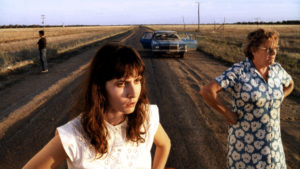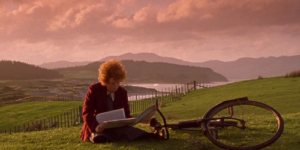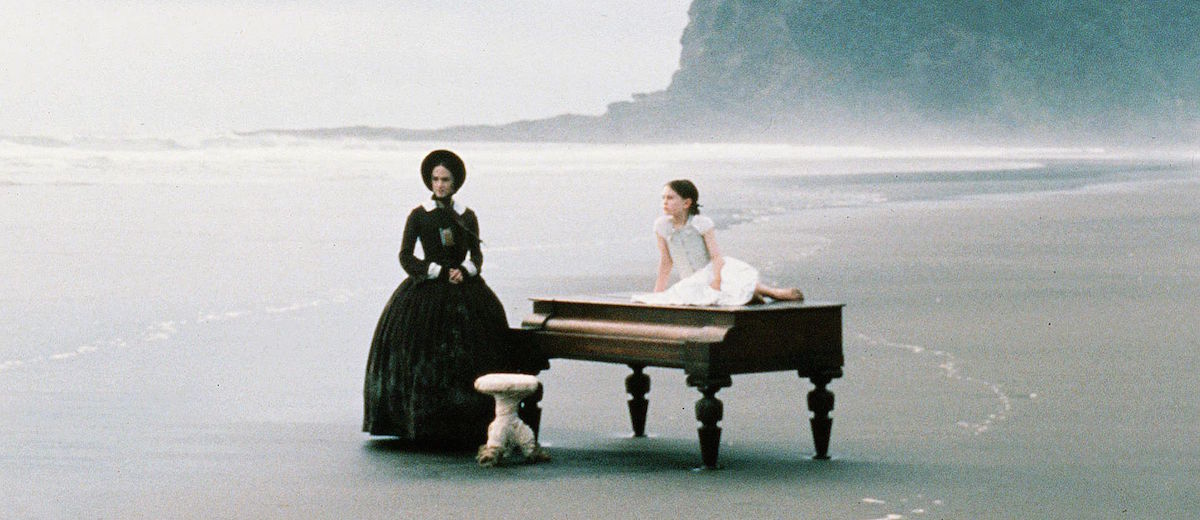In a theatre, an entire world exists. There’s aliens, robots, superheroes, and faces from another era and place that are only brought to life by the ethereal-like light that shines from one edge of the room, projecting onto the other end. There’s a silver screen, 30 feet tall and 40 feet wide, that reflects the colorful dreams of an artist determined to incarnate a reality separate from our own. But such realities help surface buried emotions and reveal a type of spiritual discord within oneself. Auteurs of the silver screen use their cameras to speak, and in doing so the general audience fills the shoes of silver screen characters, they fill the rooms of gin joints, Jazz clubs, war ships, and saloons because only an auteur can speak so clearly that the audience cannot help but to indulge in their worlds. The New Zealand-born director, writer, and producer, Jane Campion, is among the auteurs who can extract their dreams and paint it across a screen for hungry eyes to indulge in.
She began as an art student void of film or Hollywood interests, studying painting and anthropology before training at the Australian Film Television and Radio School. Her art school training, as evident from her complete oeuvre, influenced her visual style and themes. Though simply interested in painting, she then became the second woman to be nominated for an Academy Award for directing and managed to win Best Screenplay for The Piano. Campion is also the first woman to win the coveted Palme d’Or, and up until 2021 with Julia Ducournau’s win for TITANE, Campion was the only woman to receive the award.
With evidence from her powerful films spanning from her early shorts to her return to directing with her 2021 feature THE POWER OF THE DOG, Campion has expressed a poetic visual style where the camera speaks to the audience by capturing the power and vulnerability each story and character elicits. With strong visual compositions and colorful palettes that have become her trademark style, coupled with idiosyncratic framing and strange tones, Campion crafts surrealist fantasies and whimsical realities that challenge the viewer’s perspective on female desire and their strong feelings towards the world around them. In other words, Jane Campion is an auteur of the cinematic world of passion. Specifically, Campion captures the strongest and most vulnerable driving emotions of her characters that are dedicated to the creation of something (i.e., sex, religion, poetry, art, or love). She was first noticed for her student short, PEEL, a nine-minute short film that first showcased Campion’s aesthetic and trademark themes that she would soon expand on with her later film and TV endeavors like THE PIANO, AN ANGEL AT MY TABLE, and PORTRAIT OF A LADY. It also happens to be the film that won the Palme d’Or.
-

PEEL (1982)
In PEEL, the color orange is essential. A hue of orange is painted across the landscape of the taut film, citrus peels sit in the hands of a young bratty boy, and the character’s orange and red hair is presented to allude to stubbornness. This award-winning short first presented her tendency to explore themes that have to do with stifled family relationships, the transparency of men, and the abrasiveness of women. PEEL follows a short car ride with a small family of three, each being taunted by the other until the climax of scenic chaos where the dad forces his galling son out of their vehicle to pick each orange peel he left in the dust of their car while a fed-up sister locks the doors on both of them, insisting on silence. PEEL utilizes stagnant cuts and fickle framing, revealing off-kilter relationships and weary psyches, all centered around the culminating silence of a discontented woman—a primary perspective that Campion often focuses her lens around in her filmography.
But despite Campion first showcasing her visual aesthetic with PEEL, A GIRL’S OWN STORY also helped establish her as a growing auteur. In her 1984 short, Campion expresses her love for Luis Buñuel, the surrealist Spanish director of classics like THE DISCRETE CHARM OF THE BOURGEOISIE, by weaving his sensibility into her picture. The 25 minute black-and-white short is whimsical yet sinister, focusing on her now-usual diet of themes: family, women, and sexuality. But more specifically, the lyrical short follows a group of Catholic students on the brink of adulthood in a ‘60s Australia teeming with a spectrum of cultural dynamics. But the film’s style only focuses on the recurring themes that bridge female sexuality and violence, dysfunctional and amorous relationships, and sexual desire and conservative social norms. The same ideas are explored in AN ANGEL AT MY TABLE and THE PIANO, which are both centered around a troubled woman trying to find her voice much like the young women of A GIRL’S OWN STORY.
As seen in her short films, female characters and dynamics are complicated. In another of her well-received films, 2 FRIENDS, Campion continued to explore the same themes as seen in her shorts along with debuting highly complicated female protagonists. Campion’s first feature film captures the lives of two teenage girls, examining social oppression and rebellion. The complicated characters of 2 Friends are Campion’s first attempt at crafting disagreeable women that challenge the audience. Purposefully, Campion writes complicated and unlikable women whose emotions often manifest into the creation or examination of un-trekked ground. This can be seen in her second feature film, Sweetie, a story of an unconventional family and their entropic daughter.

In SWEETIE, Campion’s 1989 stunning feature which brought her international fame, the demands of feminine sexuality are on full display where two dissimilar sisters, Sweetie being the black sheep of the family with emotionally distorted ways and Kay being the unloved one with hindered sexual desires, present their sexuality as an extension of their character. Campion is careful to use the camera as Kay’s voice by presenting tilted framing to express latent subconscious fragility and a scarred psyche. The aesthetic of her picture, with leaps from warm colors to cold saturated palettes, express the chaotic emotions of Kay’s desire to receive familial warmth.
Quite simply, as seen through her presented aesthetic and cinematic language, Campion uses the camera to act as the interior to how her female characters think and feel. In Sweetie, she expresses her protagonist’s unexplored and unconscious desires with soft palettes, abrupt cuts, and idiosyncratic framing. And even with the framing of Kay, constantly cutting half of her body from the frame, Campion also expresses how she is cut off emotionally and sexually. In Sweetie, Kay, Sweetie, and their mother’s strong emotions or “passion” are edging around their subconscious. While Kay struggles to find passion with her boyfriend, Sweetie expresses it with her sexuality and style while their mother drives and hinders her emotions through her passion for singing. But Campion also crafts characters whose desires are surface level rather than just subconscious.

In Campion’s well-received book to film adaptation, AN ANGEL AT MY TABLE, the protagonist’s passion drives her to something more concrete than the subconscious desires seen in Sweetie. The film focuses on real-life author and one of New Zealand’s greatest writers, Janet Frame whose lifelong attempt to become a writer is often layered in tragedy and stripped down by social conventions. The idea of a driving passion was well-expressed in her 2009 film centering around John Keats, Bright Star. To contrast the two stories, Bright Star focuses on romantic passion as expressed through literature, while AN ANGEL AT MY TABLE highlights passion found within one’s own world of imagination. Bright Star also uses a brighter color palette and a poetic cinematic language that focuses on the amalgamation of body parts. Hands, arms, lips, and eyes are singled out in a frame, gently reminding the audience of human sensibility—a visual harmony that connects to the purpose of poetry. With AN ANGEL AT MY TABLE, warm colors dress the frame and each darkened hue only accentuates the nature of Janet Frame’s struggle through the death of her siblings, harrowing loneliness, and her forced stay at a mental institution.
In AN ANGEL AT MY TABLE, Campion once again uses the camera to express the psyche of her female protagonists. Though Campion has used tilted frames to express subconscious fragility and emotional confusion, Janet Frame is always centered and doused in warm colors. But chaotic palettes of cold blues and deep greens and warm browns and gold can be seen draped around her waist, on the walls around her, and on the people near her to express the madness of the world that overwhelms Janet, leaving her to be the only perspective that is clear and true despite Frame’s sanity constantly being in question. Furthermore, the three-hour film about Frame’s life, where Kerry Fox’s inspiring performance is seen, reveals the idea of identity and self. Janet is often seen looking through a window, utilizing it as her mirror to peer into her own self. With Janet Frame constantly framed in front of a window, the audience can sense the surrealist value of Campion’s composition. Additionally, each piece of Campion’s film is crafted to reflect a portrait of an idealized version of female perfection, but Campion uses her camera like a mirror to hold up to the faces of her audience to reveal the rough world of Janet as something that can be conquered through the powerful force of discovering one’s own passion. In result, the audience gazes at a picture where women are not Venus De Milo, but the victims of a patriarchy that forces a fantasy of perfection on women. But Janet Frame ends the film in silence, happiness, and success without ever having changed herself to conform, rather she takes the world with her pen and reimagines it, much like other female characters carefully plucked from Campion’s genius.
Other female protagonists that reimagine their world due to the oppressive nature of society are featured in Campion’s THE PORTRAIT OF A LADY, HOLY SMOKE, and IN THE CUT. Nicole Kidman’s Isabel Archer in THE PORTRAIT OF A LADY is manipulated, gaslit, and stifled by her overbearing and sinister husband. She reimagines her world through expressing her sexuality while Kate Winslet’s Ruth in HOLY SMOKE tries to escape her boring, oppressive suburban life by studying under an Indian guru. Even Meg Ryan’s character from IN THE CUT utilizes female eroticism as her avenue to freedom and a resolution. Passion drives each of Campion’s empowering female characters to danger and unexplored emotions, forcing them to confront their own identity but ultimately allowing each woman to reimagine it to their advantage.
In Jane Campion’s most successful film to date, winning her an Oscar, another Palme d’or, and Hollywood fame despite being a low-budget independent film, THE PIANO also indulges in a smorgasbord of complicated themes and female characters. The 1993 film begins with a voiceover from Ada, bravely depicted by Holly Hunter, who is using her “mind’s voice” to communicate with the audience since she is mute. The enigmatic film studies various themes: sexuality, passion, love, colonialism, capitalism, and patriarchal values, each of which are visually expressed with a camera that lingers on a moment with long tracking shots while also distancing the characters from the screen to allude to emptiness, loneliness, and emotional instability. Her aesthetic also reveals intimacy with push-ins on Ada’s face and eyes and close-ups on her hands. While the soft gleam of the picture is dipped in a cold blue hue during moments of Ada’s repression while golds and browns surround Ada’s home life, representing Ada’s hidden and repressed sexuality, Michael Nyman’s composed anachronistic music fills in the deepened emotions absent from her demeanor but expressed in Ada’s eyes.
THE PIANO is a portrait that studies sexuality as an avenue to freedom, much like Janet Frame using her ability to write to find peace. It uses Ada’s inability to speak as a symbol for living without a voice, an idea Campion seems to attach to every female protagonist in her films. But the haunting film’s power is not just the masterful screenplay or even the daunting and powerful performances. Instead, expressing passion with editing, color, composition and framing, once again, surfaces as the primary force of power in a Jane Campion movie. Campion’s dream-like film, The Piano, reveals a world of its own where emotion is the superpower that Ada must use to finally peek through her windows to finally find freedom.
-

Jane Campion Jane Campion left filmmaking behind in 2009, expressing disillusionment with the film industry. She only returned to co-write and direct the highly acclaimed TV mini-series with Gerard Lee called Top of the Lake starring Elizabeth Moss. But since Bright Star, her last feature before leaving filmmaking, Campion has been absent from Hollywood and New Zealand’s movie industry. But her 12-year hiatus from movie making has ended, as Campion’s 2021 film, The Power of the Dog, has been released to standing ovations at the Venice Film Festival and highly acclaimed reviews. It’s even poised to become a multi-winner at the 2022 Academy Awards. It’s ensemble cast is led by Benedict Cumberbatch, Jesse Plemons, and Kirsten Dunst. Hopefully, her return to Hollywood means more interesting, complicated, and nuanced characters and themes.
But nonetheless, Jane Campion’s voice remains to be an essential ingredient to the evolution of movie making and female representation because Campion quite simply refuses to allow the audience to leave the headspace of her characters. While the camera imitates the thoughts and feelings of her female protagonists, Campion’s passionate characters are only voiceless within the constraints of the three-act structure and the world built around them. To an audience, Campion is loud and clear: displaying female emotions and passion are essential to art and therefore the world. In Jane Campion’s 1989 film, THE PIANO, Holly Hunter’s mute character communicates by playing her piano. Dancing her fingers across dozens of black and white keys, her instrument speaks on behalf of her emotionality and identity. With Jane Campion, the camera quite often does the same for her, creating a colorful myriad of moments that allows the audience to live in another world for just a few hours.
Kanani Lyons has served as a programming intern for HIFF and currently works in film production as a Production Assistant in LA. Her interest in film stems from her love of classic Hollywood films, but quickly expanded to art-house cinema and beyond. She is interested in all aspects of filmmaking, including film analysis and criticism.



